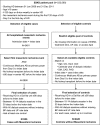The Relationship between Intradialytic Hypotension and Hospitalized Mesenteric Ischemia: A Case-Control Study
- PMID: 30237215
- PMCID: PMC6218836
- DOI: 10.2215/CJN.13891217
The Relationship between Intradialytic Hypotension and Hospitalized Mesenteric Ischemia: A Case-Control Study
Abstract
Background and objectives: Mesenteric ischemia is a rare but devastating condition caused by insufficient blood supply to meet the demands of intestinal metabolism. In patients with ESKD, it can be difficult to diagnose and has a >70% mortality rate. Patients on hemodialysis have a high prevalence of predisposing conditions for mesenteric ischemia, but the contribution of intradialytic hypotension, a potential modifiable risk factor, has not been well described.
Design, setting, participants, & measurements: We used data from the US Renal Data System to identify 626 patients on hemodialysis with a hospitalized mesenteric ischemia event (cases). We selected 2428 controls in up to a 1:4 ratio matched by age, sex, black race, incident dialysis year, diabetes mellitus, coronary artery disease, and peripheral artery disease. We used six different definitions of intradialytic hypotension on the basis of prior studies, and categorized patients as having had intradialytic hypotension if ≥30% of hemodialysis sessions in the 30 days before the event met the specified definition.
Results: The proportion of patients with intradialytic hypotension varied depending on its definition: from 19% to 92% of cases and 11% to 94% of controls. Cases had a higher adjusted odds (1.82; 95% confidence interval, 1.47 to 2.26) of having had intradialytic hypotension in the preceding 30 days than controls when using nadir-based intradialytic hypotension definitions such as nadir systolic BP <90 mm Hg. To examine a potential dose-response association of intradialytic hypotension with hospitalized mesenteric ischemia, we categorized patients by the proportion of hemodialysis sessions having intradialytic hypotension, defined using the Nadir90 definition (0%, 1%-9%, 10%-29%, 30%-49%, and ≥50%), and found a direct association of proportion of intradialytic hypotension with hospitalized mesenteric ischemia (P-trend<0.001).
Conclusions: Patients with hospitalized mesenteric ischemia had significantly higher odds of having had intradialytic hypotension in the preceding 30 days than controls, as defined by nadir-based definitions.
Keywords: Case-Control Studies; Kidney Failure, Chronic; Mesenteric Ischemia; Peripheral Arterial Disease; Prevalence; blood pressure; coronary artery disease; diabetes mellitus; end stage kidney disease; hemodialysis; hypotension; renal dialysis; risk factors; vascular disease.
Copyright © 2018 by the American Society of Nephrology.
Figures





Comment in
-
Beware Intradialytic Hypotension: How Low Is Too Low?Clin J Am Soc Nephrol. 2018 Oct 8;13(10):1453-1454. doi: 10.2215/CJN.10150818. Epub 2018 Sep 20. Clin J Am Soc Nephrol. 2018. PMID: 30237217 Free PMC article. No abstract available.
References
-
- Clair DG, Beach JM: Mesenteric ischemia. N Engl J Med 374: 959–968, 2016 - PubMed
-
- Li SY, Chen YT, Chen TJ, Tsai LW, Yang WC, Chen TW: Mesenteric ischemia in patients with end-stage renal disease: A nationwide longitudinal study. Am J Nephrol 35: 491–497, 2012 - PubMed
-
- Bassilios N, Menoyo V, Berger A, Mamzer MF, Daniel F, Cluzel P, Buisson C, Martinez F: Mesenteric ischaemia in haemodialysis patients: A case/control study. Nephrol Dial Transplant 18: 911–917, 2003 - PubMed
-
- Bender JS, Ratner LE, Magnuson TH, Zenilman ME: Acute abdomen in the hemodialysis patient population. Surgery 117: 494–497, 1995 - PubMed
-
- Schoots IG, Koffeman GI, Legemate DA, Levi M, van Gulik TM: Systematic review of survival after acute mesenteric ischaemia according to disease aetiology. Br J Surg 91: 17–27, 2004 - PubMed
Publication types
MeSH terms
Grants and funding
LinkOut - more resources
Full Text Sources
Other Literature Sources
Medical
Miscellaneous

